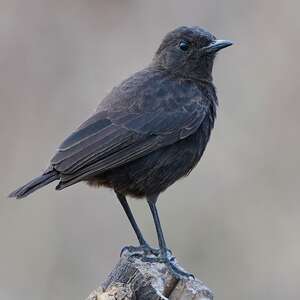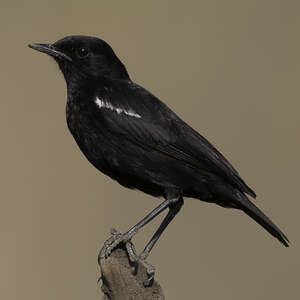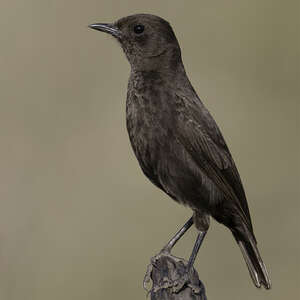Sooty Chat
Myrmecocichla nigra - Traquet commandeur
Identification
The Sooty Chat is a medium-sized, fairly stocky bird, with a fairly short tail and rounded wings. The adult male is almost entirely glossy black, with a very visible white band on the coverts. The remiges are dark brown, as are the eyes. The bill and legs are black. There is sexual dimorphism. The female is dark brown and does not show any white on the wing, except in rare cases. The juvenile looks like the corresponding adult sex, plus dull. The immature male takes on the white coverts quite early.
The female Sooty Chat can be confused with a close relative, the Brown Chat. They live in the same regions and have a fondness for the same habitats. However, the Brown Chat shows white at the base of the remiges, which can be seen well in flight.
Subspecific information monotypic species
Foreign names
- Traquet commandeur,
- Zorzal hormiguero negro,
- chasco-formigueiro-preto,
- Hadesschmätzer,
- feketehasú hangyászrigó,
- Zwarte Miertapuit,
- Sassicolo fuligginoso,
- vitskuldrad termitskvätta,
- Sotskvett,
- skaliarik černastý,
- bělořit běloramený,
- Sort Myrepikker,
- termiittitasku,
- Roetpiek,
- merla formiguera d'espatlles blanques,
- smolarek epoletowy,
- Чёрный муравьиный чекан,
- クロアリヒタキ,
- 暗色蚁䳭,
- vitskuldrad termitskvätta,
- 暗色蟻鵖,
Voice song and call
Habitat
The Sooty Chat is found from sea level to an altitude of almost 3,000 meters depending on the country and latitude, but generally at elevations over 1,500 meters such as in Kenya or Uganda. In Gambia, it is found near sea level. It likes large semi-arid grasslands with low herbage and termite mounds, including after a fire, scattered thorny bush and open acacia and mopane forests, as well as farmland and nearby villages. It is not uncommon to see it along roads.
Behaviour character trait
The Sooty Chat lives alone, in couples or in small groups mainly towards the end of the breeding season.
It is monogamous and territorial despite generally low population density. In fact, no more than 4 to 6 couples per km2 can be found in the best territory. It is used to perching at the top of termite mounds with an attitude proper to the species, namely standing up straight on its legs. It thus becomes very visible to an observer, especially since it is not wary. It also uses the clear branches of the shrubs as observation posts. Perched on the electric wires of the roadside, it stays motionless, observing and looking for prey with its eyes, occasionally flicking its tail from bottom to up, and then dropping down on them. On the ground, it runs or hops while probing the soft soil or vegetable debris with its beak.Flight
Dietfeeding habits
Reproduction nesting
There is not a set breeding season across the Sooty Chat's population. Breeding coincides with when the local rains are occurring; it can happen all year round in Eastern Africa, May-June and October in Uganda, October in Zambia, August-November in Angola, March-June in Northeastern Democratic Republic of Congo, and from September-February and in July in Southeast Africa.
The male displays at the top of bushes or termite mounds while singing and energetically flapping his wings. The nest, in the shape of a small cup made of grass and lined with fine roots, is hidden in the depths of a tunnel, a hollow log, a termite mound, or a built tunnel in a steep earthy earthen bank. The female lays 2-5 white eggs that may have light blue or thin black specks. She incubates them for 14-16 days. The species is parasitized by the Great Cuckoo.Geographic range
Sooty Chat has an irregular distribution. It is primarily found in Central-Southern Africa, from Eastern Nigeria and South Sudan in the north, to Angola and Zambia in the south, with a centre of gravity in the Democratic Republic of Congo. But even in the heart of its range, it is fragmented due to its habitat requirements. In West Africa it is found sporadically in Senegambia and Liberia. It is locally common but its distribution is irregular.
The Sooty Chat is a bird known to be sedentary. However, some poorly documented data suggests population movement in Senegal, Guinea, and Liberia.
Threats - protection
Sources of information
- IOC World Bird List (v15.1), Gill, F and D Donsker (Eds). 2025-12-07.
- HBW Alive,
- BirdLife International, BirdLife International
- Robins and Chats, Peter Clement, Chris Rose
Other sources of interest
 Specification sheet created on
22/07/2023 by Nathalie Santa Maria
Specification sheet created on
22/07/2023 by Nathalie Santa MariaTranslation by AI Oiseaux.net
© 1996-2025 Oiseaux.net
- Accipitriformes
- Aegotheliformes
- Anseriformes
- Apodiformes
- Apterygiformes
- Bucerotiformes
- Caprimulgiformes
- Cariamiformes
- Casuariiformes
- Charadriiformes
- Ciconiiformes
- Coliiformes
- Columbiformes
- Coraciiformes
- Cuculiformes
- Eurypygiformes
- Falconiformes
- Galliformes
- Gaviiformes
- Gruiformes
- Leptosomiformes
- Mesitornithiformes
- Musophagiformes
- Nyctibiiformes
- Opisthocomiformes
- Otidiformes
- Passeriformes
- Pelecaniformes
- Phaethontiformes
- Phoenicopteriformes
- Piciformes
- Podargiformes
- Podicipediformes
- Procellariiformes
- Psittaciformes
- Pterocliformes
- Rheiformes
- Sphenisciformes
- Steatornithiformes
- Strigiformes
- Struthioniformes
- Suliformes
- Tinamiformes
- Trogoniformes































